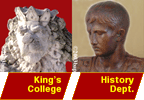|
(3 Credits)
Syllabus Spring 2019
|
 |

Prof. Pavlac
Office:
Hafey-Marian 307
Office Hours: Office hours: MW (9:20-9:50am and 1:00-2:30 pm
and by appointment.
Tel: (570) 208-5900, ext. 5748 |
Monday, Wednesday, Friday 10:00-10:50 am
Hafey-Marian 301 |

|
Salem 1692
Research Project
Salem Research Project
Purpose: The Salem Witch Hunt of 1692 and its many sources provide an opportunity for students to do substantial reading and examination of sources connected to one particular hunt. In doing so students will gain experience in the historical method.
Procedure: To properly guide you through the research process, the assingment is divided into several parts as follows.
Part One: Background reading (10 points)
By the date of Class topic Salem I do the relevant reading to familiarize yourself with the Salem hunt. Also check out Historical Theses and any relevant article in Golden, Richard M., editor. Encyclopedia of Witchcraft: the Western Tradition. Santa Barbara, CA: ABC-CLIO, 2006; in the Corgan Library: REF 133.4 En19E. In that class we will discuss the hunt and possible avenues of investigation.
Part Two: Assignment Choice (15 points).
By the date the class schedule, sign up on the office door of the instructor (Hafey-Marian 307) your choice for a research subject. If you have an alternative other than listed on the sheet, consult with the instructor before the deadline. Possible choices thus far include:
- The Social Function Theory and Salem
- The Misogyny Theory and Salem
- The Social Control Theory and Salem
- The Illness Theory and Salem
- The Disaster Theory and Salem
- The Role of The Rev. Samuel Parris
- The Role of Abigail Williams
- The Role of Ann Putnam Junior
- The Role of Ann Putnam Senior
- The Role of Tituba
- The Role of Bridget Bishop
- The Role of John Proctor
- The Role of Giles Corey
- The Role of the Rev. George Burroughs
- The Role of Judge Hathorne
- The Role of The Rev. Cotton Mather
- The Role of The Rev. Increase Mather
- The Role of Nathaniel Saltonsall
- The Role of Robert Calef
- The Role of The Rev. Deodat Lawson
- The Role of The Rev. John Hale
- The Conflict of Salem Town and Salem Village
Part Three: Source Annotations: (100 points)
You are wroite annotations on books kept on reserve in the library for this course. Each annotation should be one
paragraph long (160-250 words), which critically analyzes how that scholarly work
concerning can help you complete your project successfully.
Procedure:
- Go to the library and examine each and every book kept on reserve. You may check them out for three nights if necessary, or use copies from other libraries or book services. Be considerate of your classmates. Some of the books have primary sources as well, while many more can be found online (a good start is the page Salem Sources).
- Carefully read and/or skim the sources. An annotation both describes
and critically analyzes a book; it not only summarizes contents, but evaluates
the author's thesis, methodology, organization, use of sources, and
presentation. What is new or unique to this source? For more information, see
Library Research Guide URL: <http://kings.libguides.com/annotations>.
- For this project you only need to use these books not only for this part of the project but also for the entire research project. You must also search out and annotate at least five different primary sources (many can be found online either at Salem Sources).
- Write your source annotations, which should be a good paragraph
long, between 160 and 250 words. Briefly describe how this For scholarly books describe how the author contributes to the field of
knowledge. Most important, evaluate whether the source provides specific information that can help you complete your research project. For primary sources, describe how the source fits into the pool or evidence about the hunts. Most important, evaluate how the source provides specific information that helps you prove your thesis. Remember all sources
require full, Turabian/Chicago format citations, listed under Primary Sources and Secondary Sources in your bibliography.
- Rest, review, revise.
- Turn in
your final draft in proper presentation format, due as assigned on the class schedule.
Part Four: Research Report (25 points)
Write a two-to-three page Research Report which helps you to focus your attention on the key information you need to finish and evaluate for your seminar project. The proposal paragraph includes the following:
1. A one-sentence statement of your specific topic and thesis.
2. A description of the historical background and context (period, place, events, significant historical actors) relevant to your particular thesis.
3. A discussion of the key questions historians ask about your topic and how yours relates to them.
4. A summary of the specific sources, both secondary and primary, which you will use to support your thesis, with some explanation of historiographical issues. Primary sources found online either at Salem Sources will be important for your report.
5. Turn it in, using proper presentation format, on the date assigned on the class schedule.
Part Five: Oral Presentation (with Notes and Handout) (50 points)
Presenting
to class in a speech improves your oral communication skills in delivering understandable material to an audience.
Procedure: You will prepare notes and a handout which lists essential information to aid in your delivery. You will present your project at a time set during the presentation weeklisted on the class schedule and confirmed by the instructor.
Notes:
1. Your note information should be on 4x6 inch cards or 5 ½ x 8 ½ inch half-sheets of standard paper. They may be handwritten or word-processed.
2. Notes should only consist of phrases, terms, and bullet points. They should not be fully formed sentences and paragraphs, except where you quote directly.
3. No more than two quotations may be used, for a total of no more than 75 words.
4. Notes will be turned in immediately after your presentation.
Handout Design:
1. The handout will be made for two sides of a standard white 8 ½ x 11 inch paper .
2. Side one, arranged either horizontally, should include your title, and name at the top. The body should be presented in three sections: thesis; evidence (key terms in bullet points); and one graphic (photograph, diagram, chart, map, etc.). Appearance should not be cluttered or haphazard. Appearance should not be cluttered or haphazard.
3. Side two, arranged vertically, should include quotes from primary sources that support your project's thesis, properly cited by footnotes on the bottom.
Presentation Procedure:
1. You will distribute your handouts to the course participants before your presentation.
2. You will present from the front of the classroom. You may use a lecturn.
3. There will be no use of onscreen slides or the whiteboard. Refer listeners to your handout at appropriate times.
4. You will respond to two student questions at the end of the presentation. Some students will be chosen at random before your presentation who will be required and evaluated on the questions.
Your presentation will be evaluated on
1. Clarity of your verbal presentation, recognizing poise, word choice, pacing, audience contact.
2. Content of your verbal presentation, showing your thoughtful and informative delivery of your research.
3. The correct format of your notes.
4. The professional appearance and informative content of your handout.
5. Your response to questions showing your mastery of the material and ability to connect to wider topics.
Witch Hunt Syllabus
Although the page presents
the basic content and requirements for this project, the professor reserves the
right to change anything (e.g. assignments, point values, topics, due dates,
grading policy, etc.), at any time, at his discretion.

|
URL: http://www.brianpavlac.org/witchhunts/444SalemProj.html
Site built, maintained & © MMXIX by Brian A. Pavlac
Last Revision: 2019 March 2

|



